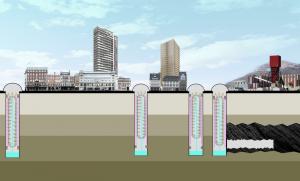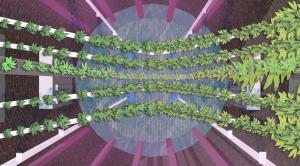Deep Farms to Revolutionise World’s Food Production
Academics at the University of Nottingham, UK, have patented a new concept that would see food production in deep farms in cities.
NOTTINGHAM, ENGLAND, UK, November 29, 2018 /EINPresswire.com/ -- Academics at the University of Nottingham have patented a new concept that would see food production in deep farms in cities. The revolutionary ideas are being promoted by University of Nottingham academics Professor Saffa Riffat, Fellow of the European Academy of Sciences and President of the World Society of Sustainable Technologies, and Professor Yijun Yuan, Marie Curie Research Fellow.
Most of the food we eat is transported by train, sea and air contributing to large CO2 emissions. For each one calorie of food we eat 10 calories of crude oil are used. Projections show that feeding a world population of about 9 billion people in 2050 would require overall food production to be increased by some 70 percent between now and 2050.
Land area for traditional farming is limited and increased food supply will require more intensive methods of crop production. Deep farming technology would allow crop production all year-round. Up to 10 crop cycles per year could be achieved compared to 1-2 cycles for conventional agriculture. Put another way, 1 indoor acre is equivalent to 4-6 outdoor acres or more, depending on the crop.
Deep Farms would eliminate the use of mechanical ploughs and other farming machinery, thus reducing the burning of fossil fuels that cause climate change. Furthermore, as Deep Farms could be located close to urban centres, CO2 emission due to transportation of crops would be reduced. This is particularly important as the proportion of people living in cities continues to rise. Over the last 20 years, the percentage of people who live in cities globally has increased from 20% to nearly 50%.
Cost-effective deep shafts for crop planting would be constructed using new drilling techniques. Existing coal mine shafts, mines and tunnels, many of which are now abandoned could also be used for crop production.
A variety of crops could be grown in the Deep Farms using hydroponic planters (plant roots fed with nutrient-rich water) or aeroponics (growing plants in an air or mist environment). LED units would enable photosynthesis in the absence of sunlight. Groundwater could be used directly or water could be condensed from ambient air in hot/humid desert climates. A major benefit of this approach is that crop production is largely unaffected by climatic or seasonal factors - one of the greatest limitations of conventional farming methods.
Many crops are now being grown in greenhouses and while this provides a controllable growth environment, greenhouses are heavy energy consumers. Vertical farms are a relatively recent adaptation of the traditional greenhouse and are suitable for use in cities, as their tall glass structures provide high crop yields on a small land area.
However, vertical farming systems are expensive to manufacture and install, and require a large amount of water and energy for heating and cooling. They are also vulnerable to extreme weather conditions, wars and terrorism.
New vertical shafts could be created for Deep Farms and also redundant coal mine shafts could be used for crop production. In the UK, for example, there are over 150,000 redundant coal mine shafts.
Carbon dioxide is required for plant photosynthesis and Deep Farms are well suited for carbon capture from ambient air. The CO2 could be released to achieve the concentration levels required by plants.
Use of carbon capture systems has the added benefit of reducing CO2 concentration in the environment, as additional carbon is adsorbed in materials in the ground space. Advanced control systems including sensors and remote controls could be used to monitor crop production. Automated systems such as robots could be used for crop planting and harvesting. Electricity generated from renewable sources and off-peak power could be used to power the LED lighting for plant photosynthesis.
Deep Farms are not strongly affected by the seasons or climates, and are resistant to natural disasters, extreme weather, pests and diseases, man-made accidents and industrial pollution. In fact, the ground environment is naturally suited to the growth of plants.
Plants can thrive in a closed environment with less oxygen and enriched levels of CO2 and water. So in terms of the rationality of the biological chain and the biological space, some crops are best located underground, leaving the ground surface for human and animal activities.
Deep Farms have many benefits including:
• Easily constructed using drilling machines and controlled explosion methods
• Effective use of abandoned mine shafts
• Carbon capture to reduce ambient CO2
• Reduced dependency on cultivated land, climate and surface water resources
• More efficient utilization of natural resources in crop production
• Improved security of crop production and reduced impact of natural and man-made factors
• Higher yields and greater cost efficiency
• Improved control over quality and food safety
• Removal of seasonal restrictions allowing production of crops all year round
• Can be used in areas with poor natural weather conditions, e.g., cold climates, and areas with low solar insolation
• Crops can be produced in desert areas, dry and water-deficient areas
• Impact of human conflict on crop production is reduced
• Crops can be grown close to highly populated areas
It is estimated that a small Deep Farm can produce 80 tonnes of food per annum. Some of the crops can be ready for harvesting within 2-3 weeks. The amount of energy it would require is equivalent to that consumed by 3 UK homes.
Crops suited to deep farming methods include:
• Lettuces and leafy greens, such as kale and spinach
• Herbs, e.g., basil, cutting celery, chives, mint and parsley
• Roots e.g., carrots and onions
• Vegetables e.g., peppers, eggplants and cucumbers
• Fruits e.g., strawberries and different types of mushrooms
Deep Farms could be installed at various locations to create a ‘Deep Farming City’. This would facilitate the supply of a wide range of fresh crops to the local population.
Professor Saffa Riffat
University of Nottingham
+44 115 748 4479
email us here
Visit us on social media:
Facebook
Twitter



